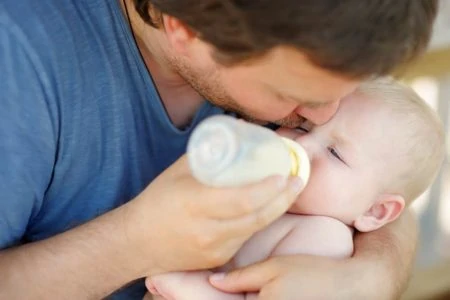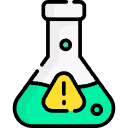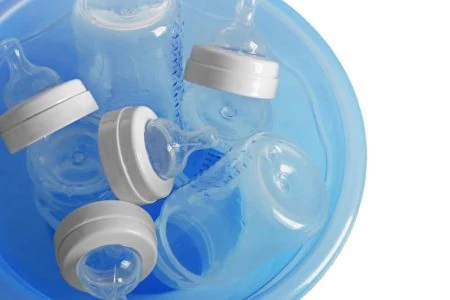Do you ever wonder if your baby’s bottle is really clean?
With babies’ immature digestive tracts and vulnerable immune systems, it’s important to make sure you’re not unknowingly introducing harmful bacteria into their little bodies through their bottles.
Sterilizing your baby’s bottles is a great way to make sure they’re safe, but the process can seem overwhelming or intimidating.
Thankfully, it doesn’t have to be. When it comes to sterilizing bottles, there are lots of ways to go about it.
Having extensively researched this topic, we’ve written this guide to show you how to sterilize baby bottles, explaining the benefits of each method and what you need to know to get started.
Key Takeaways
- Sterilizing baby bottles is important to protect babies from harmful bacteria and germs.
- There are several sterilization methods available including boiling, microwaving, using an electric steam baby bottle sterilizer, using a UV sterilizer, washing in the dishwasher, and using a diluted bleach solution.
- The best method will depend on personal preferences, lifestyle, and other factors.
- Why Should I Sterilize Baby Bottles?
- What Can Happen if I Don’t Sterilize Baby Bottles?
- What Are the Different Sterilization Methods?
- Which Sterilization Method Is Best?
- How Often Should I Sterilize Baby Bottles?
- Are Bottles the Only Thing That Needs Sterilizing?
- Things to Avoid While Sterilizing Bottles
- How Do I Sterilize Baby Bottles?
- FAQs
Why Should I Sterilize Baby Bottles?
When babies are born, their brand new digestive and immune systems are unaccustomed to the millions of bacteria we come into contact with every day. While some immunity passes from mother to baby during pregnancy and breastfeeding, babies’ immature systems are still considerably more susceptible to infection from new and unfamiliar germs (1).
For this reason, some experts recommend that parents sterilize baby bottles for the first few months of life. This will kill any germs, bacteria, or viruses that may be lurking in a bottle’s nooks and crannies, and keep your baby from getting sick.
Sterilizing your baby’s bottles is especially important if:
- You’re using secondhand or hand-me-down bottles for the first time.
- Your baby was born prematurely or has health problems.
- Your baby has been ill.
- Your home does not have safe, clean drinking water.
What Can Happen if I Don’t Sterilize Baby Bottles?
If bottles are not properly sterilized, your baby can be exposed to bacteria and germs that can cause:
- Gastroenteritis (stomach flu).
- Food poisoning.
- Diarrhea.
- Vomiting.
- Hepatitis A.
- Rotavirus.
Even if your baby can fight off the germs or bacteria associated with these illnesses, common side effects of the symptoms of vomiting and diarrhea include dehydration, which can be very dangerous for babies (2).
What Are the Different Sterilization Methods?
There are several ways to sterilize your bottles. These include:
- Microwaving the bottles.
- Boiling them in water.
- Sterilizing in cold water.
- Using an electric steam baby bottle sterilizer.
- Using a UV sterilizer.
- Washing in the dishwasher.
- Using a diluted bleach solution (make sure you follow proper instructions for this method to avoid causing harm to your baby).
Bottles should always be washed to remove any food particles before sterilizing.
Which Sterilization Method Is Best?
The result of all sterilization methods is a healthy, sterilized bottle. Aside from that, your optimal choice will depend on your lifestyle.
How Often Should I Sterilize Baby Bottles?
You don’t have to sterilize your baby’s bottles after each use. A good, thorough cleaning should keep them safe for your baby. However, it’s a good idea to occasionally sterilize your bottles in these situations:
- When they’re brand-new — before you use them for the first time.
- If your baby has been sick (especially with an oral illness like thrush).
- If you notice build-up inside the bottles or nipples.
- If you live or are traveling in an area where tap water is not regulated.
- If you get your water from a well, it may be a good idea to sterilize with every use (3).
Are Bottles the Only Thing That Needs Sterilizing?
Anything that goes in your baby’s mouth or is used to feed your baby should be sterilized. This includes:
- Bottles.
- Nipples.
- Bottle rings or accessories.
- Pacifiers.
- Feeding accessories.
- Breast pump parts (check with your manufacturer about recommended sterilization methods).
The good news is that although parents may be advised to sterilize their baby’s bottles for the first few months, it’s not considered necessary after that.
Things to Avoid While Sterilizing Bottles
The process of sanitizing your baby’s bottles is pretty easy and straightforward, so the risk of causing any harm to your baby is minimal. There are a few things to keep in mind, though.
- If sterilizing with steam or boiling water, be careful you don’t burn yourself — and don’t try to hold your baby while doing it. Even though it seems harmless, steam is far hotter than boiling water.
- If you sterilize with a bleach solution, make sure it’s appropriately diluted. Never sterilize your baby’s bottles in undiluted bleach. Bleach is a potent chemical that can be fatal if ingested.
- If your baby’s bottles contain BPA, you may want to consider using a no-heat method of sterilization or switching to BPA-free bottles. When plastic containing BPA is heated, the chemicals can leach into the milk (4).
How Do I Sterilize Baby Bottles?
Regardless of the sterilization method you choose, the first step is always to clean your bottles in hot, soapy water to remove milk residue. After your bottles are cleaned and rinsed, you can move on to sterilizing them.
1. Use the Microwave
- Make sure your microwave is clean.
- Fill your baby’s bottles halfway with water.
- Set them in the microwave.
- Place nipples, rings, and accessories in a glass bowl filled with water deep enough to cover them.
- Microwave on high for a minute and a half.
- Allow bottles to cool sufficiently before removing them from the microwave.
You can also purchase products (like this one) designed specifically for sterilizing baby bottles and other accessories in the microwave. Microwave sterilizing bags are also available.
2. Boil Them in Water
- Place your bottles in a large pot of water.
- Push down any bottles floating on the surface that are not submerged — placing a spoon on them should work fine.
- Place the pot on the stove, and turn on the burner.
- Once the water is boiling, set a timer for 10 minutes.
- After 10 minutes, remove the bottles and accessories using tongs.
- Place on a bottle drying rack.
When using this method, check with your bottle’s manufacturer to ensure the boiling-water method will not harm your bottles. It could cause plastic bottles to melt or glass bottles to crack if they weren’t manufactured to withstand this level of heat. The heat can also cause nipples and pacifiers to break down more quickly.
3. Use Cold Water
If you’re traveling, a lightweight and convenient option is a sterilization tablet. This is a product manufactured specifically for bottles, allowing you to sterilize them using cold tap water when microwave and boiling water are not available.
- Fill a container with enough water to cover your bottles.
- Add your sterilization tablet and allow to sit according to the manufacturer’s directions.
This method can be done using either a sterilization solution (liquid) or tablet (solid). If you’re traveling by air, consider the tablet over the solution due to restrictions on liquids during air travel.
4. Use an Electric Steam Sterilizer
If you’ve got countertop space, an electric steam sterilizer may be an easy solution for you.
- Place your bottles in the sterilizer.
- Add water according to the device’s instructions.
- Press the start button.
5. Use a UV Sterilizer
This may be one of the simplest options of all. Germs, bacteria, and viruses are eliminated using the power of ultraviolet light.
- Place your bottle in the sterilizer.
- Press the start button.
If you’re traveling, there are portable, single-bottle UV sterilizers available that could give you peace of mind on your travels.
6. Run Them Through the Dishwasher
This method has a caveat: not all dishwashers are capable of producing heat high enough to sterilize bottles.
Check if yours has a sanitize cycle and NSF/ANSI Standard 184 Certification (5). You’ll need to check with your manufacturer or your owner’s manual to see if your dishwasher has this certification. If it does, you can use it to sanitize your baby’s bottles by doing the following:
- Place the bottles in the top rack.
- Place any nipples, rings, pacifiers, and other accessories in a dishwasher basket.
- Run a sanitize cycle.
7. Soak Them in a Diluted Bleach Solution
- Fill a container with one gallon of water.
- Add two teaspoons of bleach.
- Mix well.
- Place bottles, nipples, and accessories into the solution.
- Allow the bottles to soak for two minutes.
- Run the bleach solution through the nipples.
- Scrub using a baby bottle brush.
- Air dry.

















